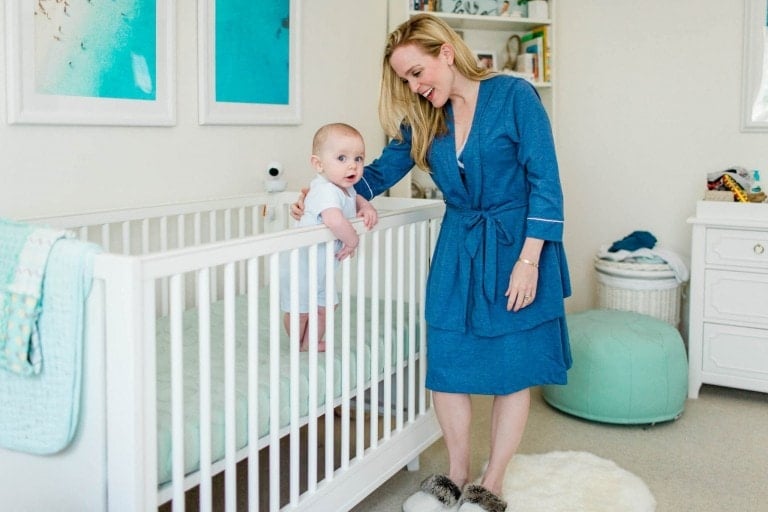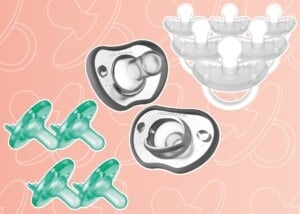Slacker boob. Quite the term, right? If you are new to the breastfeeding world, you may be a bit confused. But if you are a seasoned pro or are currently breastfeeding, you most likely know exactly what a slacker boob is.
When a mother is breastfeeding, she may notice that one breast seems to produce more milk than the other. If you’re thinking, “Oh no. This is me!” do not worry; you are not alone! While you want to rule out reasons, studies have shown that it is common for one breast to produce more than the other.1
So, What is a Slacker Boob?
The term slacker boob refers to when a breastfeeding mom has more milk output from one breast than the other.2 Some moms may refer to the higher-producing breast as their “good” breast. A difference in breast milk output is more common among breastfeeding women than you may expect. It is uncommon for both breasts to produce the same amount of milk at each feeding.1
From the start of your breastfeeding journey, a consistent difference in milk output might be apparent. This can be especially obvious for pumping moms when they see their milk production after each pumping session.2
Possible Causes of Milk Output Differences
Breast milk production is supply-and-demand driven.3 During the first few weeks of breastfeeding, it is essential to let your baby feed at each breast as frequently as they desire. The amount of milk your baby removes from your breast tells your body how much milk you need to produce to meet your little one’s growing needs.3
Even though many women report they have one breast that produces more milk, the reasons behind this phenomenon are still unclear. But let’s break down some possible reasons for having a slacker boob.
Anatomy May Play a Part
When looking at some facts about breastfeeding and the characteristics of both breasts, the first thought is that the left breast would be favorable. It tends to be the larger breast, and right-handed women generally can feed more easily from the left breast, and infants commonly prefer to turn their head to the right side.2 Yet studies have shown most women’s right breast produces milk at a higher rate than the left.4 This points us to anatomy, and even more specifically, blood flow. A recent study used Doppler ultrasound to show that the right breast has more blood flow than the left side.2 Blood flow to the breast could be the most impactful determinant of milk production.1
There May Be a Subconscious Side Preference
When it comes to breastfeeding, there may be a breast preference you are not even aware of. For mom, subconscious preference could come from which hand she is most dominant in. For right-handed women, the left breast is easier to guide the baby to, and the opposite is true for left-handed women, who may prefer placing the baby to feed on the right.2
As for babies, preference may come from how they naturally turn their heads. This could even be a result of torticollis.6 Torticollis is when a baby has tight muscles in the neck and jaw area because of confinement in a particular position during pregnancy. This can lead to a baby favoring one breast more than the other due to comfort and position.1 A baby may also find a preference for a breast if one side is easier to latch onto than the other. Nipple shape and characteristics could affect this. If a nipple is inverted, short, flat, or even too large, a baby may have a more challenging time latching.1
Will This Affect Breastfeeding My Baby?
Although one of your breasts may produce a larger output than the other, you don’t have to worry if your baby is getting enough milk. If your little one is regularly feeding and milk is being removed from both breasts, your body will continue to supply your baby with the amount of milk they need.3
The volume each breast holds will not affect your ability to feed your baby, though it may influence your little one’s feeding patterns.1 If your breast can hold a larger volume of milk, your baby may feed less frequently than a breast with a smaller volume. Breasts that have a smaller volume of milk may feed more frequently, and your baby may show hunger cues sooner and feed more often. In both scenarios, the mom makes the amount of milk their child needs, but the feeding frequencies differ.3
A difference in milk output may also lead to you subconsciously feeding your child from your “good” breast first at each feed. Your higher-producing breast may feel fuller at the start of each meal. Moms may tend to start feeding their baby on this breast to give themselves relief from the feeling of fullness. It will be important to remember to begin feeding from your “slacker” side breast to encourage more milk production there.4
Tips for Supporting Your Milk Supply
If you are concerned about your milk output on your slacker side, there are a few tips you can try that will support your supply.
Feed Baby On-Demand
For the first six months, your breastfeeding little one must be fed on demand, as often and for as long as they desire. Watch for feeding cues such as rooting and placing their hands to their mouth to know when the baby is ready to eat again.3
Offer the Slacker First
By placing the baby to feed on your lower output breast first, they will have more opportunities to drain the milk from that breast. The better the breast is drained, the more it will be encouraged to produce more milk.4
Pump Your Slacker Side
It is important to drain your breasts to maintain milk supply and support an increase in supply. After breastfeeding, you can pump your lower-producing breast to fully drain it, signaling your body to produce more milk. When pumping, use the correct flange size, though you can use a size up. A larger flange diameter allows for the ducts in your breasts to expand and create more milk flow.1
Maintain a Good Latch and Position
A proper latch and position are always essential when breastfeeding. Good positioning of your baby can lead to a good latch while breastfeeding. A good latch will help the baby “pull” milk effectively from the breast and help prevent nipple pain for the mother.3
It is important to note that your body may produce the perfect amount of milk for your baby, just a little lopsided. Signs that your little one is receiving enough milk can include:
- Gaining appropriate weight5
- Having an amount of wet and dirty diapers that is appropriate for the baby’s age5
- Baby is happy and satisfied after each feeding for a period of time5
Make sure to speak with your pediatrician to discuss appropriate milestones your baby should meet regarding development, weight, and the number of dirty diapers.
Though the reason behind the differences in milk production of each breast remains theoretical, having a slacker boob is common.2 You may be eager to increase your supply on your slacker side, but your baby is likely getting all the nutrients they need. Though you may feel a bit lopsided sometimes, I hope reading this article helps you know you are not alone!











